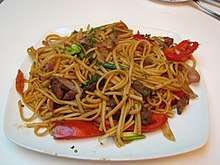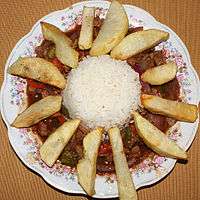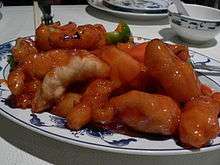Chifa
Chifa is culinary tradition based on Chinese Cantonese elements fused with traditional Peruvian ingredients and traditions. Though originating in Peru, the Chifa tradition has spread to neighboring countries like Ecuador, Chile and Bolivia. Chinese immigrants came to Peru mainly from the southern province of Guangdong and particularly its capital city Guangzhou in the late 19th and early 20th centuries. They settled for the most part in the coast of Peru and the capital city of Lima.[2] The term chifa is also used to describe a restaurant where this type of food is served.[3] Chinese-Peruvian food has become one of the most popular types of food in Peru. The first Chinese–Peruvian fusion restaurants were opened in Lima in around 1920 in Lima's China town (Barrio Chino); there are thousands of Chifa restaurants across all districts of Lima and many more throughout other cities of Peru, with sometimes multiple independent restaurants operating in close proximity on a single city block.
 |
| Chinese cuisine |
|---|
|
|
Overseas cuisine |
|
Ingredients and types of food |
|
Etymology
The origin of the term chifa comes from the Cantonese 饎飯 (Jyutping:ci3 faan6) which means "to cook rice or to cook a meal." A similar loanword, "chaufa", comes from the Cantonese 炒饭 (Jyutping:caau3 faan6) or "fried rice." Many other words in the Peruvian colloquial language that are of Chinese origin include: "kion" from Cantonese 薑 (Jyutping: goeng1), and "sillao" from the Cantonese 豉油 (Jyutping si6 jau4).
History
As Chinese immigrants in Peru progressed economically, they imported a limited number of ingredients to be able to produce a more authentic version of their home cuisine. Additionally, they began to plant a variety of Chinese vegetables with seeds imported from China. However, due to a lack of ingredients, the Chinese were not able to prepare their cuisine in the authentic manner of their homeland.
| This article is part of a series on the |
| Culture of Peru |
|---|
_alternative_version.svg.png) |
|
History
RecentPresidency of Martín Vizcarra (2018-current) |
|
Arts and literature
|
|
Entertainment
|
|
|
|
Peru portal |
Around 1920, the first Chinese Peruvian restaurants were opened in Lima and were given the name Chifa. The Limean aristocracy was amazed by the bittersweet sauce, chaufa rice, the soup, and other dishes of the ancient cuisine. From that moment on, wealthy Limeans became fascinated by Chifa, to an extent that in some regions of the country there are more chifas than creole (which here is used to refer to the natives) restaurants.
Additionally, Peruvian chefs began to use products used in traditional Chinese cooking such as ginger, soy sauce, scallions, and a variety of other ingredients which began to make their way into daily Limean cuisine.
There are different accounts on the development of chifa restaurants in Lima, the Peruvian capital, such as the following:[4]
"Why is the Chinatown of Lima near the central market called Capon? Because on Ucayali Street pigs, bulls, sheep and goats were fattened to be made more appetizing. Near Capon Street there was a piece of land known as Otaiza, which was rented by a group of Chinese free of the [indenturement] contract, free to chart their own horizon doing what they best knew how to do: cooking and merchanting (...) Capon turned into the birthplace of Chinese food and of the first Peruvian chifas, a blessing from the sky. Soon all of Lima comes to eat at Ton Kin Sen, to Thon Po, to Men Yut, and to San Joy Lao where there was even dancing to a live orchestra. (...) At one time or another, nobody knows when, Chinese restaurants began to become known as Chifa. For some this word was derived from the Chinese ni chi fan or "Have you eaten yet". Soon later would come the dish chau fan (fried rice), and finally, chaufa, a dish that comes with almost every chifa meal."
- León, R., 2007 pp.134-136.color
As stated, the history of chifa is deeply rooted in the development of the Chinatown of Lima, originally prepared by unhealthy or unsavory methods, but which has become focal point in cultural, artistic, commercial, and especially gastronomic interest. Chinatown is located near Capon Street in Barrios Altos, in the Historic Centre of Lima.
Cuisine
Peruvian chifa is distinct, mostly due to its Peruvian cuisine influences, from Chinese food found in other parts of the world although certain aspects found in Chinese food internationally are common to Peruvian chifa such as wontons, fried rice (chaufa), sweet and sour sauce, and soy sauce. Like most Chinese food internationally and within China, rice, meat, noodles and vegetables are important staples to chifa. Chifa is enjoyed by all socioeconomic levels, as evident by the ability to find chifas directed towards those with a more ample budget and seeking a more refined atmosphere whereas chifas de barrio are directed towards a different social strata and do not have the same level of atmosphere and are directed towards consumers accustomed to the type of food which they serve. Currently, in the city of Lima there are over 6,000 chifa restaurants.[5]
Chifa dishes
| Name | Image | Description |
|---|---|---|
| Arroz chaufa | Cantonese-Peruvian style Fried Rice (white rice, soy sauce, scallions, fried egg, and meat such as chicken or pork) | |
| Tallarin Saltado |  | Cantonese-Peruvian style Chow Mein |
| Lomo Saltado |  | Stir-fried marinated sirloin strips with onions, tomatoes and peppers and served with french fries and rice. |
| Gallina Chi jau kai | Chicken with Chu-Hou sauce | |
| Gallina Tipa Kay |  | Chicken with Sweet and Sour sauce. |
| Pollo enrollado | Chicken rolled into fried crust | |
| Chicharron de gallina | Fried simmered chicken cubes served with spiced lemon juice | |
| Pollo con tausi | Seasoned chicken with a dark broth | |
| Aeropuerto | A mixture of Arroz chaufa and Tallarin saltado | |
| Wantan frito |  | Fried wonton |
| Sopa Wantan | Cantonese-Peruvian style Wonton soup | |
| Kam Lu Wantan | Wontons stir fried with Sweet and sour sauce, vegetables and meat | |
| Sopa estilo chifa | Chinese-style chicken soup | |
| Sopa Fu chi fu | Egg drop soup | |
| Taypa a la plancha |  | Stir fry of beef, pork, chicken, fried tofu puffs, seafood, vegetables |
Chifas in other countries
Since at least the 1970s, Chinese immigrants had also opened chifas in neighboring Ecuador.[6] Chifas have also been opened in Bolivia and Chile.[7]
See also
- Chinese cuisine
- Peruvian cuisine
- Chinese Peruvians
- Chinatown of Lima
- Chinese Latin American cuisine
Notes
- Acosta González, Martín (29 May 2011). "La jugosa historia del lomo saltado, un plato fruto del mestizaje: Tal como lo conocemos hoy, se trata de un plato relativamente joven que vio la luz gracias a la fusión de sabores de la cocina peruana y china" [The juicy story lomo saltado, a dish result of crossbreeding: As we know it today, it is a relatively young dish which was created by the fusion of flavors of Peruvian and Chinese Cuisines]. El Comercio (Peru) (in Spanish).
- Rodrigues Pastor, Humberto (Oct 2004). Cuando Oriente Llegó a América, Contribución de los inmigrantes chinos, japoneses y coreanos (in Spanish). Lima. ISBN 9781931003735.
- "Chifa". Diccionario de la Real Academia Española (in Spanish) (vigésima segunda edición ed.).
- León, 2007, pp. 134-136.
- "Chinese in Peru: Soul food". Commission Magazine. November 2002. Archived from the original on 2007-04-23.
- "Los chifas se comen el mercado ecuatoriano". Hoy (Ecuadorian newspaper) (in Spanish). 2006-04-26. Archived from the original on 2013-07-24.
- https://www.citizen-times.com/story/news/local/2019/01/02/peruvian-chicken-latin-food-asheville-restaurant-conosur-mills-river-mackensy-lunsford/2117811002/
References
- León, Rafo (2007). Lima Bizarra. Antiguía del centro de la capital. 2da edición (in Spanish). Lima-Perú: Aguilar. ISBN 978-9972-848-17-9.
External links
| Wikimedia Commons has media related to Chifa. |